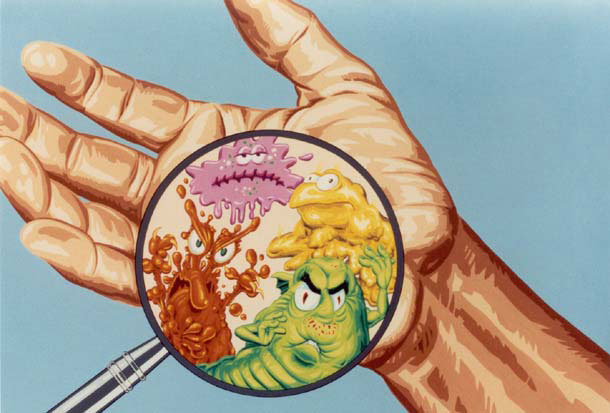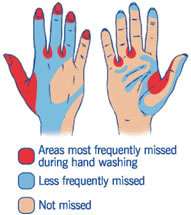Hand Hygiene = Healthier Workplace
Hand hygiene knowledge varies from person to person and place to place. In the workplace, some employees may not know the proper way to wash their hands. National Handwashing Awareness Week is Dec 1-7, 2013, an excellent time for employers to review proper hand hygiene with their workers.
 About 80% of infectious diseases are transmitted by unclean hands touching contaminated surfaces.1 Some viruses and bacteria can live two hours or longer on tables, doorknobs, and telephones. When workers touch their face, germs enter their body through the eyes, nose, and mouth. Germs are also transmitted to others by shaking hands or handling items that others then touch.
About 80% of infectious diseases are transmitted by unclean hands touching contaminated surfaces.1 Some viruses and bacteria can live two hours or longer on tables, doorknobs, and telephones. When workers touch their face, germs enter their body through the eyes, nose, and mouth. Germs are also transmitted to others by shaking hands or handling items that others then touch.
Many cases of colds, flu, and foodborne illness are spread by unclean hands, and these diseases are responsible for billions of dollars each year in health care expenditures and productivity losses in the workplace. The best protection from these types of illness is frequent handwashing to get rid of potentially harmful bacteria.2
When to Wash Hands at Work: 3
- Each time an employee uses the restroom
- Before and after staff meetings if food is served
- After scanning newspapers or magazines in the break room
- Before and after lunch

- After using a coworker’s keyboard or tools
- Before and after a meet and greet activity
- When using shared office equipment like copiers, phones, etc.
Recommended Handwashing Technique: 4
- Use soap and warm, running water
- Lather and wash hands thoroughly, including wrists, palms, back of hands, fingers, and under fingernails for at least 20 seconds (length of singing Happy Birthday twice)
- Rinse hands well under warm, running water
- Dry hands thoroughly with a clean paper or cloth towel or air dryer
Workplaces are encouraged to establish this three-step Hand Hygiene Program: 5
- Train employees to use good handwashing methods. This includes education on how and when to wash hands in the workplace, but also at home to avoid spreading illness to family members.
 Develop handwashing policies on how and when to wash hands, and communicate these to employees via meetings, email and signage. Posting reminders on mirrors in bathrooms or nears sinks and soap dispensers will help staff reconsider leaving the bathroom without washing their hands.
Develop handwashing policies on how and when to wash hands, and communicate these to employees via meetings, email and signage. Posting reminders on mirrors in bathrooms or nears sinks and soap dispensers will help staff reconsider leaving the bathroom without washing their hands.
- Supply the restroom with materials that make handwashing easy and pleasant such as touch-free hand soap dispensers and an adequate supply of touch-free single-use paper towels. In addition, sinks should provide warm water and be clean. Hand sanitizer should also be available throughout the workplace for times that employees cannot make it to the sink but need to clean their hands.
Bradley’s 2013 Health Handwashing Survey 6 found that 93% of Americans believe the condition of a workplace restroom is an indicator of how a company values its workforce. Unfortunately, 63% said they had an unpleasant experience in a public restroom due to the condition of the facilities. The survey also found that staying healthy is an imperative for employees. 81% said they consciously take steps to avoid the germs of sick colleagues. Proper hand hygiene is a key step in decreasing the transmission of disease in the workplace.
1 National Center for Preparedness, Detection, and Control of Infectious Diseases (NCPDCID) and National Center for Zoonotic, Vector-Borne, and Enteric Diseases (NCZVED), http://www.cdc.gov/CDCTV/HandsTogether/
2http://www.webmd.com/cold-and-flu/cold-guide/cold-prevention-hand-washing
3 The American Cleaning Institute
4 “Get a Grip on Handwashing,” 2010 Brochure, American Society for Microbiology and the American Cleaning Institute.
5 Three Easy Steps to Starting a Hand Hygiene Program at Work, Dr. Allison Aiello, Tork Better Business Center
6 2013 Bradley’s Handwashing Survey